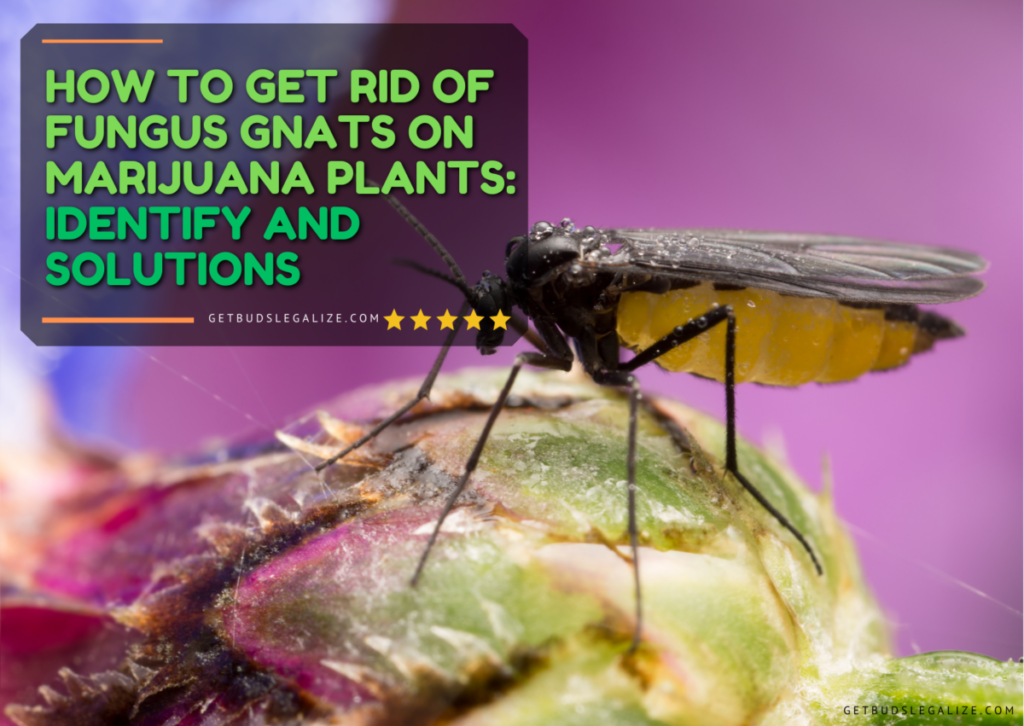How to Get Rid of Fungus Gnats on Marijuana Plants: Identify and Solutions
If you are growing cannabis plants in soil, you may encounter a common pest problem: fungus gnats. These tiny flies look like mosquitoes with dark wings, and they can infest your soil and damage your plants’ roots.
In this blog post, we will explain what are, where they come from, how they affect your plants, and how to get rid of them for good.
What Are Fungus Gnats?
Fungus gnats are small insects that belong to the order Diptera, which includes flies and mosquitoes. They are typically found in moist environments where fungi grow, such as potting soil, compost, or decaying plant matter.
Fungus gnats have slender bodies and long legs, and their wings are often veined and transparent. They vary in color from black to gray to brown, depending on the species, and are usually less than 1/8 inch (3 mm) in length, making them hard to see with the naked eye.
Fungus Gnat Life Cycle:
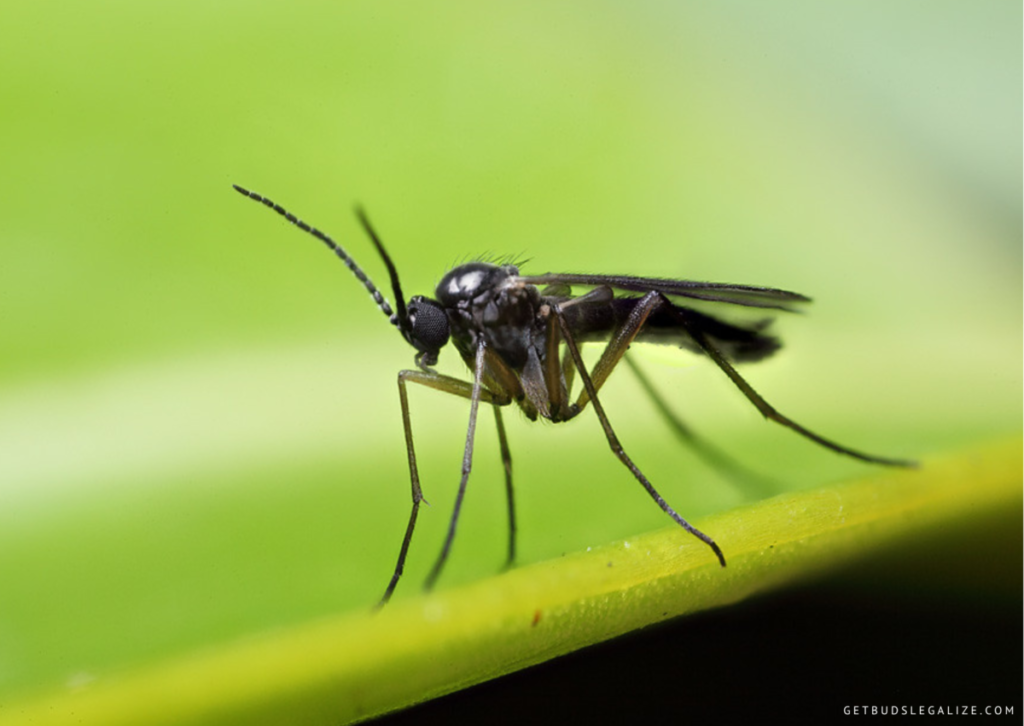
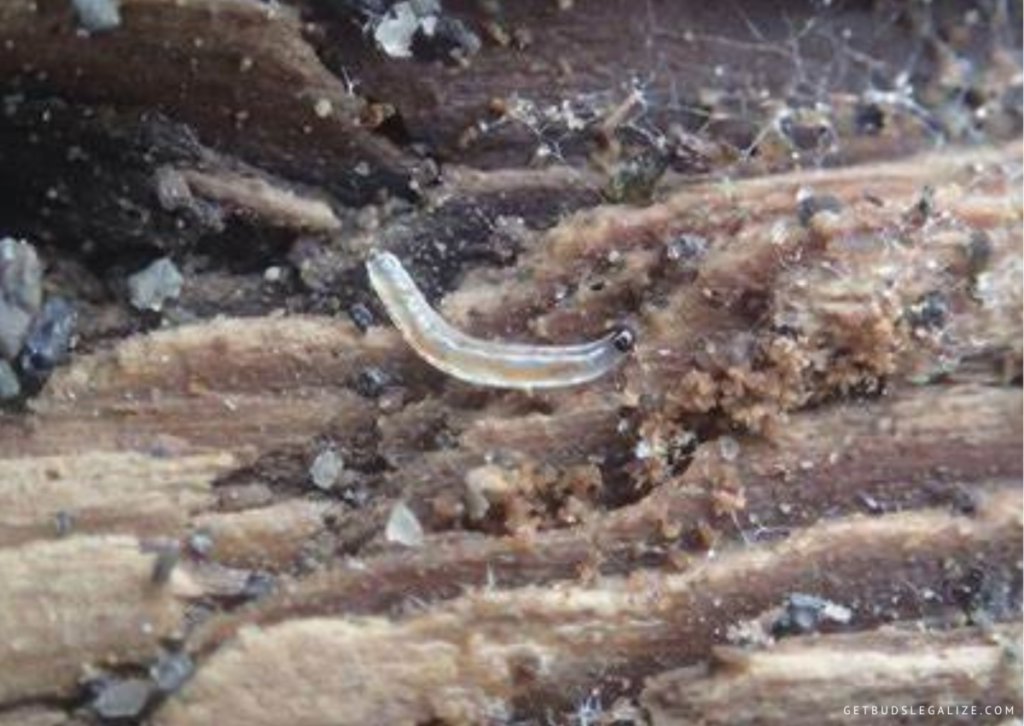
Their life-cycle is divided into four stages: egg, larva, pupa, and adult. The eggs are laid in moist soil or organic matter and hatch in four to six days. The larvae feed on plant roots, fungi, and decaying organic material for 12 to 14 days before pupating.
The pupae emerge from the soil after four to six days and transform into winged adults.
The adults fly around plants, windows, and lights for eight to 10 days, laying up to 200 eggs in their brief lifespan. Fungus gnats can damage plants by reducing their growth and vigor, as well as spreading diseases and pests.
What Are the Causes of Fungus Gnats' Infestation?
Some of the most common causes of their occurrence can be attributed to:
1. Overwatering:
Excessive watering creates favorable conditions for fungus gnats to breed and feed. The moist soil allows the fungi to grow and provides a food source for the adult and larval gnats. Overwatering also reduces the oxygen level in the soil, which can harm the plant roots and make them more susceptible to fungal diseases.
2. Poor Drainage:
Poor drainage can also lead to overwatering and fungus gnat infestation. If the soil doesn’t drain well, it can hold too much moisture and create a soggy environment suitable for gnats.
Poor drainage can be caused by using the wrong type of soil, potting compost, or container for the plant. It can also be caused by plugged or blocked drainage holes in the pot or tray.
3. Organic Matter:
Organic matter such as dead leaves, stems, flowers, or fruits can attract fungus gnats. These materials can decompose and release nutrients into the soil, which can stimulate the growth of fungi and bacteria.
Fungus gnats can feed on these microorganisms and lay their eggs in the organic matter. Organic matter can also reduce the air circulation in the soil and increase the humidity level.
4. Mulch:
Mulch is a layer of material that is applied on top of the soil to conserve moisture, suppress weeds, and improve soil quality. However, mulch can also cause fungus gnat infestation if it is too thick, wet, or contains too much organic matter.
Mulch can create a dark and moist environment for the gnats to thrive and hide from predators. Mulch can also prevent the soil from drying out and reduce the airflow in the soil.
How Do Fungus Gnats Harm My Cannabis Plants?
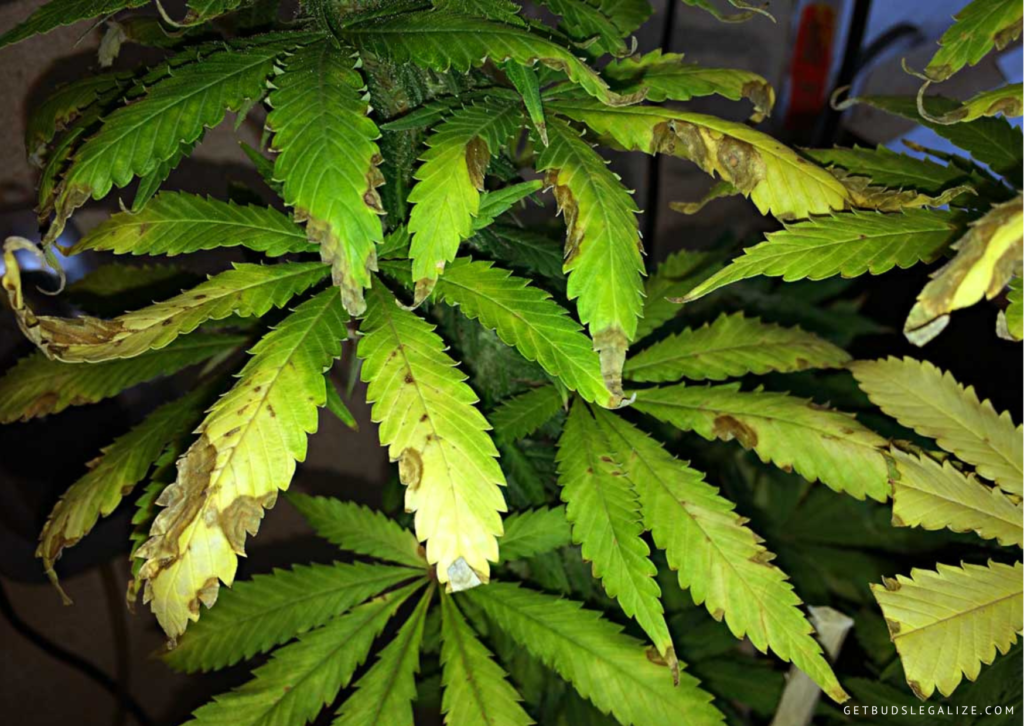
This tiny insect can harm cannabis growth in several ways:
• They contaminate your soil with their droppings, which can affect the drainage and pH of the soil and make it more prone to other fungal or pest issues.
• They damage the roots of your plants by feeding on the root hairs and sometimes the larger roots. This reduces the ability of your plants to absorb water and nutrients and can stunt their growth and yield.
• They transmit fungal diseases such as Pythium, Fusarium, or Botrytis, which can cause root rot, damping off, stem rot, or bud rot, which can kill your plants or ruin your harvest.
• They can attract other pests, such as spider mites or thrips, that can further damage your plants.
How to Identify Fungus Gnats Infestation?
To identify their presence by looking for these signs:
- Adult gnats flying around your plants or near windows.
- Larvae crawl on the soil surface or in the drainage holes of pots.
- Yellowing or wilting leaves due to root damage.
- Mushy or soft stems and roots due to fungal infection.
What Are the Symptoms of Fungus Gnats on Your Plants?
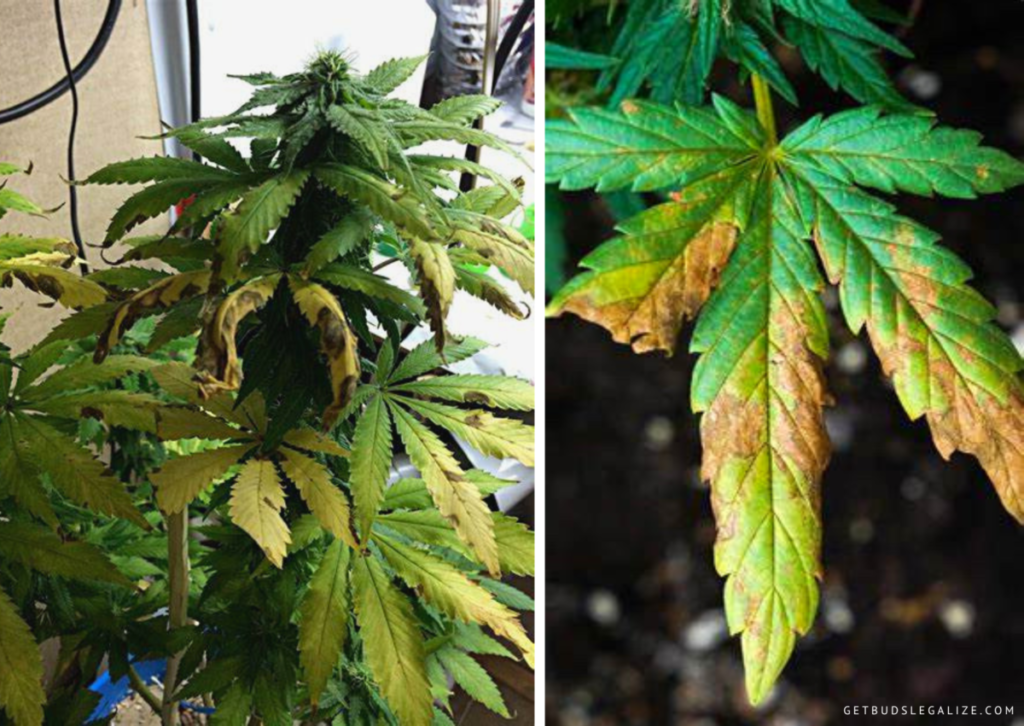
Some of the signs and plant symptoms you may experience are:
- Seeing adult gnats flying around your plants or soil
- Finding larvae or pupae in the soil when you water or transplant your plants
- Noticing yellowing, wilting, or drooping leaves
- Observing slow growth or reduced yield
- Detecting root rot or damping-off symptoms
How to Get Rid of Fungus Gnats on Marijuana Definitely?
Fortunately, there are several ways to get rid of fungus gnats on marijuana plants. Here are some of the most effective methods:
1. Biological Pest Control:
Introduce beneficial Nematodes in your grow room. Nematodes are microscopic worms that parasitize and kill gnat larvae in the soil. You can buy them online or from garden centers and apply them to the soil according to the instructions. They are harmless to plants and humans and can persist in the soil for several weeks.
2. Using Sticky Paper Traps:
These are yellow or blue cards coated with a sticky substance that attracts and traps adult fungus gnats. You can place them near the soil surface or hang them above the plants. They can help reduce their population and also monitor their activity.
3. Using BT Bacteria (Bacillus Thuringiensis Israelensis):
This is a natural bacterium that infects and kills fungus gnat larvae in the soil. You can find it in products such as mosquito dunks or bits, which you can crush and mix with water or sprinkle on the soil surface. BTI is safe for your plants and beneficial insects.
4. Using Neem Oil:
This is a natural oil extracted from the neem tree that has insecticidal and fungicidal properties. You can spray it on your plants’ foliage and soil surface to repel and kill adult gnats and prevent fungal diseases. The Oil of Neem is also effective against other pests, such as spider-mites or aphids.
5. Using Pyrethrin:
This is a natural insecticide derived from chrysanthemum flowers that kill adult fungus gnats on contact. You can spray it on your plants’ foliage and soil surface to quickly knock down fungus gnats. Pyrethrin is also effective against other pests, such as whiteflies or caterpillars.
6. Using Hydrogen Peroxide:
This is a common household product that can kill the larvae and eggs in the soil. You can mix it with water at a ratio of 1:4 and use it to water your plants once every week until you see no more signs of fungus gnats. Hydrogen peroxide will also oxygenate the soil and help your plants’ roots.
7. Appling Diatomaceous Earth:
Diatomaceous earth is a natural substance made of fossilized algae that have sharp edges that can cut and dehydrate fungus gnats and other pests. You can sprinkle it on the top layer of the soil and around the pots to create a barrier that prevents fungus gnats from laying eggs or emerging from the soil. Be careful not to inhale it or get it in your eyes as it can be irritating.
How Do I Prevent Fungus Gnats from Infesting My Plants?
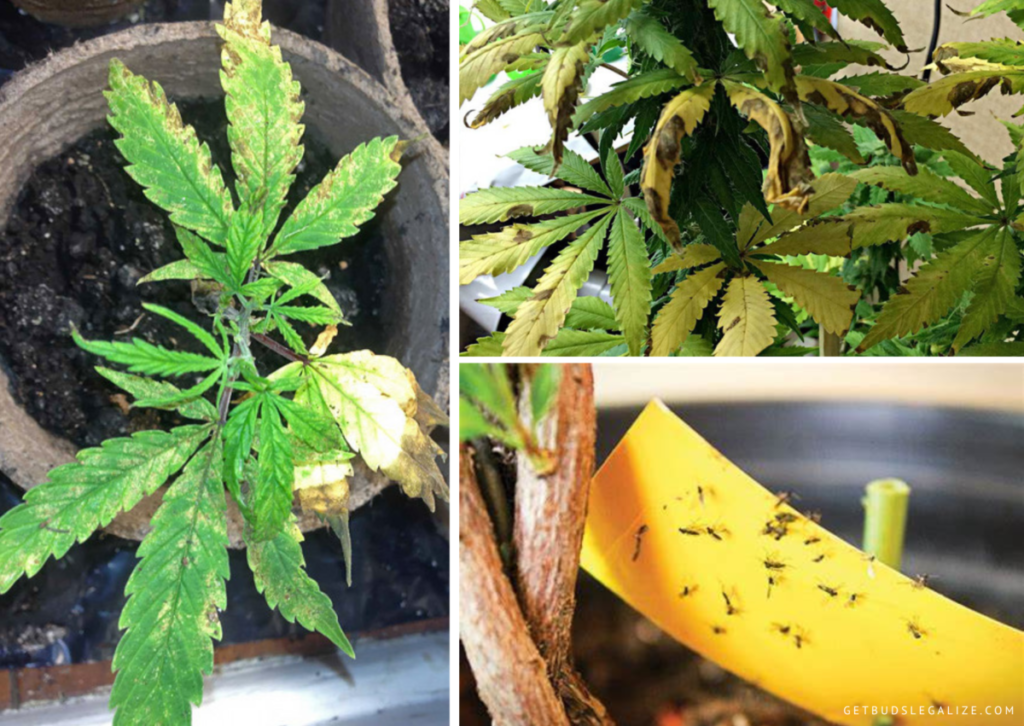
Here are some steps you can take to them from invading your cannabis plants:
• Avoid Overwatering Your Plants: Fungus gnats thrive in wet conditions, so let the soil dry out between waterings. You can use a moisture meter or your finger to check the soil moisture level before watering.
• Use a Well-Draining Potting Mix: Potting soil that holds too much water can create a favorable environment for their presence. Choose potting soil with perlite, vermiculite, or sand to improve drainage and aeration.
• Cover the Soil Surface With a Layer of Sand, Gravel, or Perlite: This can prevent them from laying eggs in the soil and reduce their access to organic matter. Make sure the layer is at least an inch thick and covers the entire surface of the soil.
• Remove any Dead or Decaying Plant Matter From The Soil and The Pot: Fungus gnats feed on organic matter, so removing any debris can reduce their food source and discourage them from breeding.
• Use Yellow Sticky Traps to Catch Adult Fungus Gnats: They are coated with a sticky substance that attracts and traps fungus gnats. Place them near the soil surface or hang them from the plant stems. Sticky paper traps are available at garden centers or online.
• Apply a Natural or Chemical Insecticide: There are various products that can kill them or their larvae. You can use neem oil, diatomaceous earth, hydrogen peroxide, or bacillus thuringiensis as natural options, or choose a chemical insecticide that is labeled for fungus gnats. Follow the instructions on the label and apply with caution.
• Use a Sterile Potting Mix for Your Plants: Some potting mixes may contain organic matter that can harbor fungus gnats or their eggs. You should choose a potting mix that is free of compost, bark, or peat moss, and sterilize it before using it for your plants. You can sterilize the potting mix by baking it in an oven at 200°F for 30 minutes, or by microwaving it for 10 minutes on high power. This will kill any fungus gnats or other pests that may be present in the potting mix.
• Keep Your Grow Room Clean and Well-Ventilated: This will help prevent their growth and reduce humidity levels in the air. You should also remove any dead leaves or plant debris from the soil surface and dispose of them properly. You can also use a fan or an exhaust system to improve air circulation and lower the temperature in the grow room.
• Let the Topsoil Dry Out Between Waterings: This is the most important step to prevent and control fungus gnats. By reducing the moisture level in the soil, you will discourage fungus growth and egg laying. You can use a moisture meter or your finger to check if the soil is dry enough before watering again.
Conclusion
Fungus gnats on marijuana are annoying pests that can ruin your plants if left unchecked. By following these tips, you can prevent them from invading your growing space and quickly get rid of them if they do.
Fungus Gnats on Weed Plants - FAQS
Fungus gnats are small insects that belong to the order Diptera, which means they have two wings. They can use their wings to fly, but they are not very good at it. They usually stay close to the soil surface, where they feed on organic matter and fungi. Fungus gnats are not harmful to humans, but they can damage plants by laying eggs in the roots or stems.
Fungus gnats on marijuana thrive in moist, organic soil and stagnant air. To prevent and eliminate them, you should:
- Reduce the watering frequency and let the top layer of soil dry out between waterings.
- Increase air circulation in your grow tent with a fan and unblock any vents or openings.
- Use Yellow sticky paper traps to catch adult gnats and monitor their population.
- Apply a soil drench with hydrogen peroxide or a biological control like Bacillus thuringiensis (BT) to kill the larvae.
- Reintroduce beneficial microbes to your soil with a compost tea mix after treating the infestation.
To get rid of them during flowering, you can use a combination of methods, such as:
- Using yellow paper traps to catch the adult gnats and reduce their population.
- Spraying a diluted solution of neem oil or hydrogen peroxide on the soil and foliage to kill the larvae and repel the adults.
- Watering your plants less frequently and letting the soil dry out between waterings to discourage the gnats from breeding.
- Introducing beneficial predators, such as nematodes or predatory mites, to feed on the gnats and their larvae.
Fungus gnats can kill your plants if the infestation is severe and left untreated.
The best way to get rid of them is to use a combination of methods, such as:
- Reducing the moisture level of the soil by watering less frequently and improving drainage.
- Applying a layer of sand or gravel on top of the soil to prevent the gnats from laying eggs.
- Using yellow paper traps to catch the adult gnats and monitor their population.
- Spraying the plants with a solution of water and oil of neem, which is a natural insecticide that repels and kill fungus gnats.
- Introducing nematodes to the soil, which are microscopic worms that feed on their larvae and other soil pests.
Here are some possible solutions:
- Use hydrogen peroxide to kill the larvae and adults. Mix one part of 3% hydrogen peroxide with four parts water, and spray the stems and leaves of infested plants where the gnats are visible. You can also water the soil with this solution to kill the eggs and larvae.
- Reduce the frequency and amount of watering your plants. Fungus gnats need moist soil to survive, so letting the top layer of soil dry out between waterings can discourage them from laying eggs. You can also try bottom-watering your plants, which means letting them soak up water through their drainage holes instead of pouring it over the top.
- Remove any dead or decaying plant matter from the soil surface. Fungus gnats on marijuana feed on organic matter, so clearing out any debris such as dead leaves, flowers, or grass clippings can reduce their food source. You can also cover the soil with a thin layer of sand, gravel, or perlite to prevent them from accessing the soil.
They do not attack flowers directly, but they can damage the roots and lower stems of the plants. This can affect the growth and yield of the cannabis crop. Fungus gnats can also spread diseases and pests to other plants in the same area.
ILGM Fertilizer
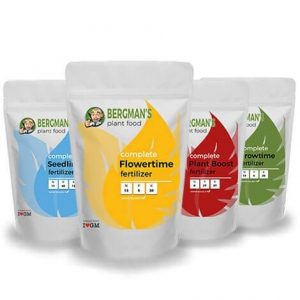
- From seedling to harvest, give your plants everything they need.
- Enough for feeding at least 5 plants.
- Discounted Package Deal
- Works well in soil and hydroponics
- The best way to treat your plants
ILGM Plant Protector
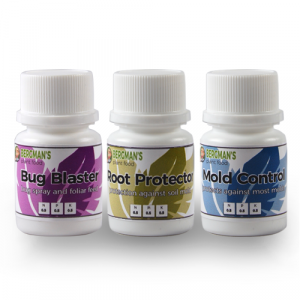
- Protect your cannabis from diseases and harmful pests.
- Contains three 20 ml bottles.
- Enough supplies to protect 20 plants.
- It can be used in soil and hydroponic

